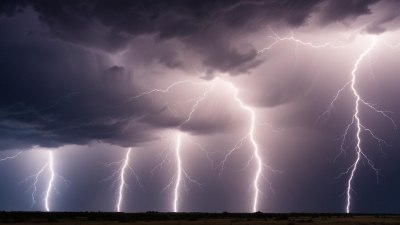Why Some Lightning Flashes Are Horizontal
Explore the reasons behind horizontal lightning flashes and their fascinating characteristics.

This image was created with the assistance of Freepik
When we think of lightning, the first image that often comes to mind is a jagged, vertical flash illuminating the sky. However, not all lightning obeys this conventional form. Horizontal lightning flashes are a captivating phenomenon, challenging our understanding of electrical discharge in the atmosphere. This article delves into the science behind why some lightning bolts appear horizontal, examining the factors that contribute to this unique display.
The Basics of Lightning Formation
Before diving into the specifics of horizontal lightning, it’s essential to understand how lightning forms. Lightning is essentially a massive electric discharge, triggered when electrical charges within clouds become imbalanced. Thunderstorms create conditions ripe for this charge separation, with ice particles colliding and generating static electricity. When the charge differential becomes severe, a sudden discharge occurs in the form of a lightning bolt.
Types of Lightning
There are several types of lightning, including cloud-to-ground, intra-cloud, and cloud-to-cloud. Cloud-to-ground (CG) lightning is what most people observe, where a bolt travels from a cloud to the earth. Intra-cloud lightning occurs within a single cloud, while cloud-to-cloud lightning involves discharges between separate clouds. Horizontal lightning typically falls under intra-cloud and cloud-to-cloud categories and rarely manifests in the standard vertical fashion.
Conditions Favoring Horizontal Lightning
Several atmospheric conditions contribute to the occurrence of horizontal lightning. Firstly, strong wind patterns can influence the direction of thunderstorms and thus alter the path of lightning. When winds are intense, they can stretch the electrical discharge horizontally rather than vertically, leading to longer, more diffuse bolts.
Thunderstorm Dynamics
Thunderstorms themselves are dynamic systems. In certain scenarios, the updrafts and downdrafts within a storm can become unbalanced. For example, an updraft may allow a charge to build up significantly in one section of a cloud, while downdrafts simultaneously create an opposite charge elsewhere. When the discharge occurs, it can travel horizontally across the cloud, creating a spectacular visual display that is equally beautiful and electrifying.
Geographical Influence
The geographical setting where lightning occurs can also play a role in its horizontal presentation. In flat terrains with fewer obstructions, such as plains or over oceanic expanses, lightning has more room to extend horizontally. Conversely, in mountainous regions, the presence of elevation changes can direct lightning vertically. Flat landscapes can facilitate a longer horizontal discharge, allowing the bolts to stretch across vast distances.
Temperature and Humidity Effects
Weather conditions, particularly temperature and humidity, are crucial in determining how lightning behaves. High humidity can lead to more charged particles within a storm cloud, increasing the probability of horizontal discharges. Additionally, temperature gradients can influence how quickly the electrical discharge travels, with warmer conditions possibly allowing for longer horizontal trajectories.
The Role of Electric Fields
The strength and direction of the electric field within a storm cloud are vitally significant. Lightning follows the path of least resistance, and strong electric fields can guide the discharge along particular routes. If the field is more conducive to horizontal movement, the lightning will follow suit. Scientists employ tools like lightning detection networks to study the orientation of these electric fields during storms, offering insights into how they influence lightning behavior.
The Science of Intra-cloud Lightning
Intra-cloud lightning serves as a fascinating example of horizontal flashes. These discharges occur within a single cloud instead of reaching the earth. Unlike typical CG lightning, intra-cloud flashes can link sections of clouds that might be far apart vertically or horizontally, creating a web of electrical connections. As the charge moves within the cloud, it can appear to travel horizontally, again influenced by the previously discussed wind patterns and charge separation.
Weather Patterns and Horizontal Lightning
Specific weather patterns are associated with increased occurrences of horizontal lightning. For example, squall lines, a type of weather front characterized by a line of severe thunderstorms, can promote horizontal lightning. These thunderstorms often involve intense winds and rapidly shifting atmospheric conditions that support horizontal discharges, showcasing the interconnectedness of various meteorological phenomena.
Lightning Safety
Understanding the behaviors of different types of lightning, including horizontal flashes, is critical for ensuring safety during thunderstorms. While horizontal lightning can appear more visually impressive, it is essential to remember that all forms of lightning pose significant dangers. Safety measures include seeking shelter indoors during storms, avoiding open fields, and staying away from tall structures. Awareness and preparedness are key to minimizing risks associated with lightning.
Conclusion
The phenomenon of horizontal lightning serves as a fascinating intersection of meteorology, physics, and nature’s artistry. By understanding the various factors that contribute to this electric spectacle, we can appreciate the complex systems at play within our atmosphere. As scientists continue to study lightning, we gain a deeper understanding not only of electrical discharges but also of the broader weather phenomena that shape our planet.











